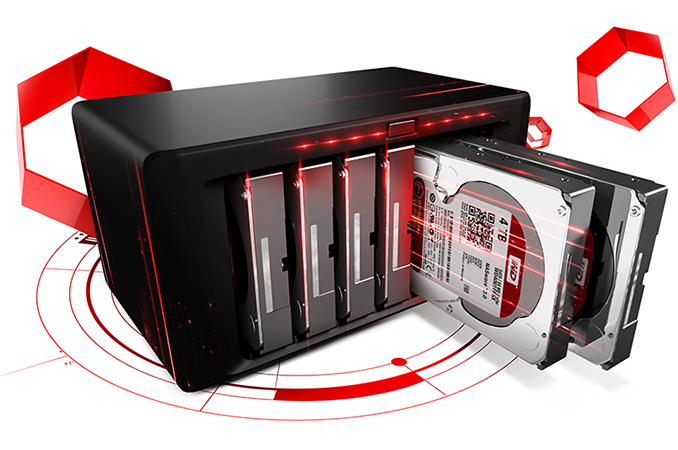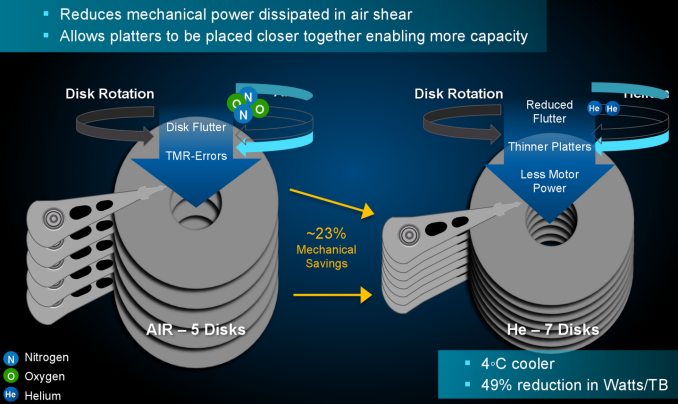Western Digital Introduces Its First Helium-Filled HDDs for Consumer Applications
by Anton Shilov on March 1, 2016 8:00 AM EST
Helium-filled hard drives have a number of mechanical advantages compared to traditional HDDs, but they are also more expensive to manufacture. Western Digital subsidiary HGST introduced the world’s first commercial helium-filled hard drive in 2013, targeting datacenters. Since then, the company has launched two more generations of its helium drives, including two models with 10 TB capacity. This week Western Digital unveiled the world’s first family of helium-filled HDDs designed for consumer applications, which will be sold under the WD brand.
The family of WD’s hermetically-sealed helium-filled hard drives will include WD Red, WD Red Pro and WD Purple 3.5” internal HDDs as well as My Cloud, My Book and My Book Duo external storage systems based on the new drives. Western Digital’s first helium-filled WD HDDs feature 8 TB capacity and HelioSeal technology for hermetic sealing. WD confirmed that the upcoming WD Red, WD Red Pro and WD Purple hard drives may include components and technologies originally designed by HGST, but the WD drives are not re-branded Ultrastar He10-8 HDDs with six platters. While it is logical to expect the new helium-filled WD-branded drives to use the same 1.33 TB PMR platters as the datacenter-class HGST Ultrastar He10-8 HDDs, Western Digital has not confirmed that.
WD is not disclosing much int he way of technical details about its new hard drives, but indicates that they are based on different platforms that are tailored for their respective applications. For example, the WD Red 8 TB and the WD Purple 8 TB helium-filled HDDs feature 5400 RPM spindle speed, whereas the WD Red Pro 8 TB will sport 7200 RPM-class spindle speed. Like other contemporary HDDs, the new helium-filled drives from WD will feature 4 KB sectors, but will also support 512 byte sectors using emulation. Just like their predecessors, the new hard drives come with SATA III (6 Gbps) interface.
Since the WD Red 8 TB is aimed at personal or small business NAS systems with up to eight bays, it is optimized for mixed workloads. The WD Red Pro 8 TB is engineered for small business and enterprise-class NAS systems with up to 16 bays, which is why the drives feature extra protection against vibrations, larger caches and improved random read performance (thanks to both 7200 RPM spindle speed and firmware tuning). The WD Purple 8 TB drives are designed for surveillance applications that operated 24/7 and required support for ATA streaming technology, writing-related optimizations, as well as protection against vibration in systems with up to eight HDDs.
The density of helium is one-seventh that of air, which reduces drag force acting on the spinning disk stack and lowers fluid flow forces affecting the disks and the heads, allowing for platters to be thinner and a larger number to be packed more densely. Meanwhile thanks to helium and increased areal density of platters, the new WD Red, WD Red Pro and WD Purple HDDs will increase sequential read/write performance, lower power consumption and reduce noise levels compared to their predecessors. Unfortunately, precise specifications of the new drives will only be available when the HDDs are commercially released later this year.
Initially, Western Digital will only offer My Book (WDBFJK0080HBK) and My Book for Mac (WDBYCC0080HBK) external HDDs with 8 TB capacity for $299.99 in select U.S. stores as well as online. Typically, WD’s My Book external storage systems use hard drives with 5400 RPM spindle speed. Therefore, it looks like Western Digital starts to sell the basic helium-filled consumer-class HDD first, which is a logical decision for a brand new platform. It is noteworthy that while the new external drives are not cheap, they are around $70 more expensive than Seagate’s Archive internal 3.5” drive with 8 TB capacity and SMR platters (which has been on the market for well over a year). It is hard to say whether Western Digital has managed to develop an inexpensive helium-filled HDD platform, but it certainly looks like the company intends to use helium in order to increase capacities of its high-end hard drives and without needing to implement SMR. At present, Western Digital only uses its helium platform for NAS drives, but eventually it may adopt it for its high-performance WD Black HDDs for desktops.
The hermetically-sealed helium-filled internal WD HDDs will be available later in H1 of this year, just like My Cloud- and My Book Duo-series storage systems with multiple drives.
Source: Western Digital











34 Comments
View All Comments
megalee - Tuesday, March 1, 2016 - link
You don't understand the physics. Just like osmosis, the helium atoms diffuse to where there are less helium atoms. So they will diffuse out even if equal pressure until the loss in pressure equals the "pressure" to drive them out. As was stated in another post, the air will not diffuse/leak into the drive because Nitrogen and the other components of air do not diffuse through materials as easily. Now if there was an actual defect casuing a leak, then the air would get in and the helium escape.nandnandnand - Tuesday, March 1, 2016 - link
Maybe they can expect it because both WD/HGST and Seagate spent nearly a decade developing the HelioSeal technology, and millions of the drives have been shipped.linker3000 - Wednesday, March 2, 2016 - link
I'll just go ask the 6 x 6TB He6 drives in one of my servers - that's the disks date stamped May and June 2013.Danvelopment - Tuesday, March 1, 2016 - link
Does that mean price/GB on regular drives are dropping yet? Or do they still remain unchanged from 2012?Their unwillingness to lower prices in the face of such rapidly dropping NAND prices is what will eventually seal their fate.
In the same time NAND has gone from 40x more costly per GB to 7x more costly today.
Communism - Tuesday, March 1, 2016 - link
Considering the massive challenges of semiconductor feature size reduction at the moment, the Hard Drive manufacturers have nothing to fear at the very least until EUV lithography comes online commercially in 3-8 years.NAND probably will never catch up to hard drives in price per capacity due to the massive loss in durability when lowering lithographic nodes as well.
The gap will most likely be filled by the NAND successor, RRAM (3D XPoint)
Danvelopment - Wednesday, March 2, 2016 - link
When comparing against the lowest tier drives, maybe. But WD Reds, Blacks, Purples and Enterprise drives are pretty pricey compared to these and I don't see NAND remaining much higher than them for long. From what I remember the original 850 Evos were on a 40nm node and SSDs are down to what, 32c USD/GB?That's quite a lot of room for die/cost shrinks, and Samsung has already proven excess density isn't the issue with that 16TB concept in 2.5". They're not scraping margins, and if they can increase volume at a lower cost/GB by adding more density they could lower their margins but increase overall profitability without needing to ship any more units.
At that point they'd likely find they do ship a lot more units. Enterprise is looking pretty closely at them as well, the sheer IOPS from them is just completely incomparable to a HDD, and I'm sure Samsung is carefully weighing its current margins to a theoretical "close-enough" point when it would be silly to buy an HDD. I wouldn't be surprised if they suddenly went from 20c/GB to 10c/GB in one big jump when they finally hit 20.
Communism - Wednesday, March 2, 2016 - link
What you don't understand is that 15nm/19nm Toshiba is the lowest cost node until Micron and Toshiba up their game on 3D NAND stacking to put pricing pressure on Samsung.3D NAND stacking also doesn't lower prices in the same way that node shrinks do, as the wafers per day is not equivalent, therefore the areal 2D density advantage of 3D NAND doesn't factor in the same way.
TL/DR: Moore's law died for realzies this time, in everything.
Samus - Wednesday, March 2, 2016 - link
I was suspicious as most in IT are with new technology when HGST released the Ultrastar HE, but we've had pretty good luck with them at various clients in NAS applications. We had one fail in a RAID5 array on a mail server with 6 drives, but had a spare on-site so swapping in was no problem, and this isn't terribly unusual. I wasn't there to see it, and it was shipped in for a warranty exchange before I got to plug it in and see what SMART errors there were and run any tests. Basically the RAID array said it failed and the guy on-site pulled it immediately.To this day I'm curiously exactly what went wrong with it, if anything was wrong with it at all. Sometimes these Areca RAID cards just kick a disk out that's fine and just needs an integrity check, especially under sustained 24/7 workloads like a mail server (that was also running a SQL database, so basically high demand.) This was April 2015 and they were put into service in March 2014.
I'm excited to see these hit the consumer space. I'd rather have a hermetically sealed drive than a shingled recording drive...time will tell exactly how reliable SMR is, just like time has proven the He6 is.
Communism - Wednesday, March 2, 2016 - link
What's the point of even running databases on 8TB hard drives in RAID5 instead of just going the SSD route?Either you are stacking ungodly amounts of DRAM as cache or you are just doing extremely large basically never accessed datasets?
SkipPerk - Monday, March 7, 2016 - link
I have historically dealt with 30 gb to 2 T databases, adn doing all-flash for that is prohibitively expensive, expecially if you are mirroring the whole thing for perfect redundancy (a necessity with my crap).The only time I see all-flash is where yuo need speed, and even then they have those huge RAM caches. Personally i have seen large RAID arrays with gib ole spinning drives do amazingly well withe those huge RAM sans. They are faster than all flash. Those mixture HDD, SSD, and RAM multi-level cache thingy's are the only ones I have never seen in action. They do look like they would solve a lot, but for lots of stuff simply having insanely fast RAM caches are more than adequate for big RAID storage for DB's. At least for me I tend to see usage where there are heavily-used small DB's or heavily used views or reports made off of views and the entire high-usage areas are only 30-40gb. If you have > 60gb RAM cache, the rest if kind of irrelevant. The idea of having a terabyte flash layer in between seems like a waste.